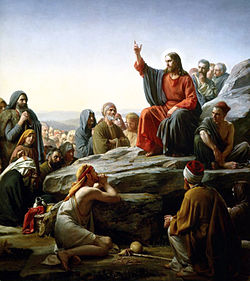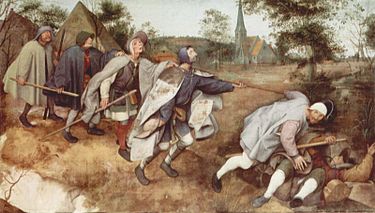Bible: What Does Luke 6 Teach Us About the Sabbath, Judging Others, and the "Golden Rule"?
Luke

Harmony in the Gospels?
Do you believe the Gospels can be harmonized?
Sabbath Teaching
A textual divergence and individual stylistic differences again arise within the gospels.
Whereas the Majority Text contains the rather odd sounding “on the second Sabbath after the first” (v. 1a), NU has “on a Sabbath.”
[Why NKJV follows the first reading is puzzling.]
Luke does not mention (but assumes) the disciples’ hunger (v. 1b; cf. Mt. 12:1); he also finds delight in noting that they rubbed the heads of grain in their hands (v. 1c).
Matthew predictably includes a more extensive Scriptural discussion than does Luke, showing how “the spirit of the law” takes “priority over the letter of the law” (vv. 2-5; cf. Matt. 12:3-8).
Mark adds, “The Sabbath was made for man, not man for the Sabbath” (2:27).
Luke apparently believes that the “healing of the man with the withered hand” incident took place “on another Sabbath” in the local synagogue (v. 6a), and not on the same day as the grain field confrontation.
Both he and Mark merely note that the scribes and Pharisees present “watched him [Jesus] closely,” but said nothing (v. 7; cf. Mk. 3:2).
Matthew records that the Jewish leaders actually asked Jesus, “Is it lawful to heal on the Sabbath?” (12:10).
In fact, Luke writes the unique insight that “He knew their thoughts” (v. 8a).
Again, both Luke and Mark cut short the conversation, having Jesus give the Jews “the bottom line” (v. 9; cf. Mk. 3:4).
Matthew, however, includes the hypothetical situation that Jesus used to illustrate His point (12:11-12a).
Luke writes that Jesus merely “looked around at them all” (v. 10), but Mark actually reveals the Lord’s emotional status (“with anger, being grieved with the hardness of their hearts”) [3:5].
Matthew, on the other hand, does not even mention that He looked at the Jews.
Interestingly, NU indicates only in Matthew that Jesus restored the man’s withered hand so that it became “as whole as the other” (12:13).
“Filled with rage” describes the Jews’ internal condition, according to Luke (v. 11); Mark leaves out their emotions this time, but adds that the Pharisees consulted with Herodians about how to destroy Jesus (3:6).
The time for the Lord to choose His “apostles” draws near; instructive it is to note what each evangelist emphasizes.
Mark stresses three points:
Christ called men whom
(1) “He Himself wanted”;
(2) He appointed “that they might be with Him”; and
(3) He sent out to preach, cure sicknesses, and cast out demons (3:13-15a).
Matthew mentions the last point only, minus the preaching (10:1).
As for Luke, he writes nothing about Jesus’ desires or about any of the authority He delegated; instead, he notes that the Lord spent the whole night in prayer to God (v. 12).
[Luke’s contribution to the list of apostles appears (vv. 13-16); see Matthew 10 for a full discussion of this matter.]
The Sermon on the Mount

John MacArthur
In his approach to Luke’s truncated version of the “Sermon on the Mount,” Ryrie surmises that the account “may simply be similar teaching given on a different occasion” (New Testament Study Bible, 117).
The evangelist sets the stage similarly to Matthew, introducing the address in the context of an extensive healing “crusade” (vv. 17-19; cf. Matt. 4:23-25).
(Mark, addressing a Gentile audience, does not deal with the Sermon at all).
Luke includes the rhetorical form: four “Blessed . . . for” statements and one “Rejoice . . . for . . . for” conclusion (vv. 20-23).
[Matthew records nine of the former category; the latter form remains essentially the same.]
Verses 24-26 declare the reversal of the “beatitudes” in the form of “woes”—something Jesus did not do (according to Matthew’s Sermon account.)
[One cannot contend that He is against the rich, the full, the happy, and the popular per se; only when these conditions and ambitions constitute the supreme values of one’s life does Jesus condemn them.]
The necessity of responding to enemies as God does comprises a significant part of Luke’s record (vv. 27-36).
Showing love by doing them good, blessing them, and praying for them should characterize those “who hear” (vv. 27-28).
Self-defense does not seem to be an option for the believer when the violent and the thieving assault and rob him (vv. 29-30).
[This instruction runs counter to “normal and rational” human reaction.]
As for their part, those who hear ought to treat others as they themselves desire others to treat them (v. 31).
Their godly, kind, and merciful responses toward enemies should distinguish them from “sinners” (vv. 32-35a), earn them great reward from God, and exemplify their relationship to Him (“sons of the Most High”) [vv. 35b-36].
Repetition of rhetorical formulae characterizes Jesus’ teaching; the latest example occurs in verses 37-38 which contain four statements—two negative and two positive—each appearing as imperatives but functioning as conditionals.
Both apodoses (conclusions) to the two negative imperatives state emphatically (aorist subjunctive used with ou me) [Goetchius, The Language of the New Testament, 269] that he who keeps himself from judging and condemning will certainly not be judged or condemned in turn (v. 37).
Likewise, he who practices forgiveness and the giving of his goods (i.e., he obeys the positive commands) will himself benefit from forgiveness and material increase (v. 38a).
In fact, the greater “measure” that one gives, the greater return one will receive (v. 38b).
[These imperatives serve as examples of the so-called “Golden Rule.”]
The Blind Leading the Blind

Judging Others
view quiz statisticsTo convince His audience that the Pharisees operate as spiritually blind guides (v. 39), Jesus relates a parable having imagery that depicts them as leading their disciples into a ditch (v. 39a).
These followers, when fully “trained,” will likewise lead their disciples into danger (v. 40).
[Of course, the principle works both ways.
A disciple “perfectly trained” in the truth of his Master will come to resemble Him and lead his disciples in the way of righteousness.]
Jesus’ illustration about removing specks and planks (vv. 41-42) fits into His discussion of judging others (v. 37a). In order for one to judge another aright, one must remove one’s own “plank” (blind spot) first.
Changing the metaphor from a carpentry-related concept to an agricultural one (that is, fruit trees), Christ teaches that the quality of fruit/life production depends upon the quality of the tree/heart producing it (v. 43).
One should not expect to produce good fruit from an abnormal growth (thorn or bramble) (v. 44).
What one speaks is a good indicator of the contents of one’s heart; the moral status of one’s “heart” (core of being) determines the quality (good or bad) of one’s speech (v. 45).
Luke adds a rhetorical question from Jesus that Matthew does not insert into his “Lord, Lord” dialogue (v. 46; cf. Matt. 7:21-23).
[One can read His question without noting His exasperation with them, but it is difficult.]
The details of Christ’s parable (as Luke relates them) also differ significantly from Matthew in several particulars, suggesting that this sermon is not the Sermon.
The particulars include:
First, the noteworthy proviso “Whoever comes to Me” [v. 47a];
Second, the present progressive participle of “build” (as opposed to the aorist indicative of Matthew) with the additional “who dug deep and laid the foundation”—clauses that Matthew does not have—(v. 48a);
Third, Luke’s lack of mentioning any wind (cf. Matt. 7:25, 27), but his inclusion of “the stream” beating “vehemently” against the house being unable to “shake” it (v. 48b); and
Fourth, the change from “sand” (Matt. 7:26) to “earth without a foundation” (v. 49).
While the differences appear too great to harmonize into one sermon, those facts do not indicate that they, in fact, are too great or that any error exists.
© 2013 glynch1







